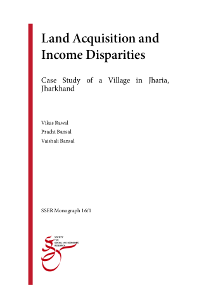This paper presents a study of the impact of land acquisition and displacement on the livelihoods of people in Belgaria, a village in Dhanbad district in Jharkhand. The study village, Belgaria, is on the margins of the coal mines in Jharia. Agricultural land acquired from the village in 1982 was used to construct a township and rehabilitate about 1200 families displaced by underground fires and land subsidence in Jharia. Using this village as a case study, this paper shows that, in a location with considerable degree of differentiation in ownership of land, the impact of land acquisition on livelihoods of people can vary across households belonging to different classes. Evidence from the new Belgaria township, where families displaced by underground fires were rehabilitated, shows that the resilience with which displaced workers coped with the disruption in access to livelihoods varied across male and female workers, and across socio-economic status of displaced households. Livelihoods of workers who were engaged in casual labour in the coal fields, in particular women workers, were most adversely affected due to displacement.
See the full monograph here.
Recommended citation:
Rawal, Vikas, Bansal, Prachi and Bansal, Vaishali (2016), Land Acquisition and Income Disparities: Case Study of a Village in Jharia, Jharkhand, SSER Monograph 16/1, Society for Social and Economic Research, New Delhi (available at: http://archive.indianstatistics.org/sserwp/sserwp1601.pdf).

